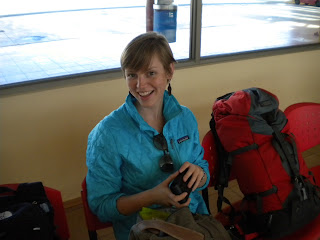Windy and cold!
Luego,
compramos unas cosas bonitas a la feria artesanal. ¡Teníamos que visitar todas
las ferias posibles! Obvio. Al fin, despedimos a Pablo y tomamos un bus a
Puerto Montt donde nos quedamos por una noche antes de nuestro vuelo en la mañana.
No teníamos mucho tiempo para conocer la ciudad, pero pedimos a la mujer al
hotel para una recomendación para un restauran muy cerca. ¡Nos dijo que había uno
abierto así que fuimos y Dios mío, era increíble! Sirven comida típica chilena,
pero mejor. Para empezar, comimos sopaipillas fritas con la versión chilena de
pico de gallo. Yo comí porotos con rienda y mi mama comió (mi favorito) cazuela
de ave. Por supuesto hacen helado casero también. Delicioso y estábamos las únicas
personas allá.
Porotos con rienda. It is definitely more delicious than it looks, haha.
Antes de ir
al aeropuerto la mañana siguiente, tratamos de encontrar el mercado de pescado.
El hombre al hotel nos dijo que debe tomar como diez minutos para caminar. Después
de 30 minutos, encontramos una (espera…) feria artesanal. No mercado pero,
bueno. Vimos unas cosas interesantes durante el paseo.
In Puerto Montt. If someone could explain, that'd be great. I'm as tall as her shoe!
Puerto Montt. Busts of important military figures. There is a strong naval presence here.
From the penguin colony, we went to Ancud, a ‘big’ city in
the north of the island. It was cold and raining so we didn’t want to spend
much time outside. We saw (for maybe 2 minutes) an old Spanish fort that they
used during the war for independence.
Spanish fort in Ancud
Then, we bought some beautiful items at a fair. We had to
visit all of the fairs possible! Obviously. Wrapping up our time in Chiloe, we
said goodbye to Pablo and took a bus to Puerto Montt where we stayed for a
night before our flight in the morning. We didn’t have much time to get to know
the city, but we asked the lady at the hotel for a restaurant recommendation
nearby. She told us there was one place open so we went and my gosh it was
incredible! They serve typical Chilean food, but better. To start, we had fried
sopaipillas with the Chilean version of pico de gallo. I had porotos con rienda
and my mom ate (my favorite) cazuela de ave. Of course they also make homemade
ice cream. Delicious and we were the only people there.
View from our hotel in Puerto Montt.
Cazuela de ave
Homemade ice cream with wild strawberries. Yes please.














































